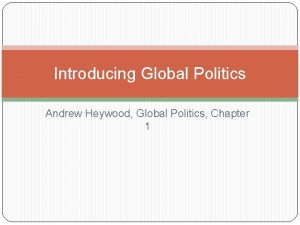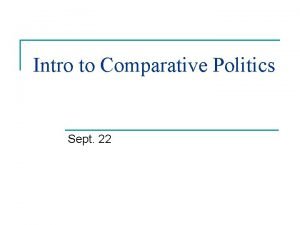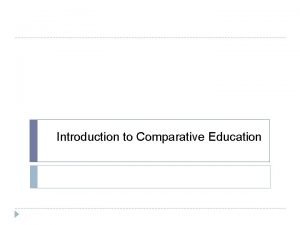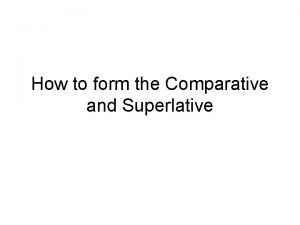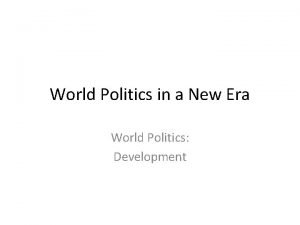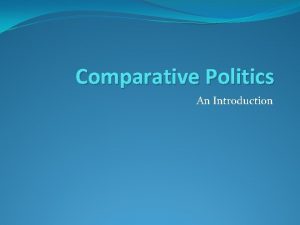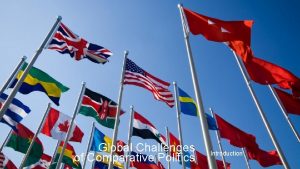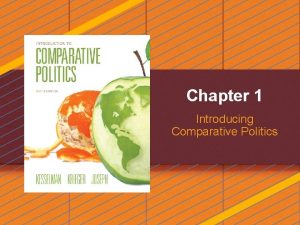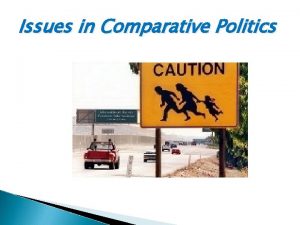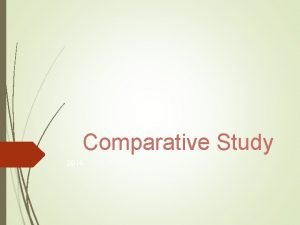CH 1 POLITICS Introduction to Comparative Politics I










- Slides: 10

CH. 1 POLITICS Introduction to Comparative Politics

I. The Comparative Method • The process by which different cases are compared in order to better understand their qualities, and to develop hypotheses, theories, and concepts • Typology: A system of classification based on groupings or types with common sets of attributes • Comparative politics—field within political science politics that focuses on domestic politics and analyzes patterns of similarity and difference in political systems • Social system involved in making authoritative public decisions.

I. The Comparative Method • Two basic ways to make comparisons – Normative Comparisons: Focuses on philosophies, norms, or “should” • “Should all democracies offer universal health care? ” – Empirical Comparisons: Drawing conclusions on the basis of facts, measurement, or observation. • “Do all democracies have universal health care? ”

I. The Comparative Method • Comparative politics through much of the Cold War (late 1940 s–early 1990 s) was dominated by the – Three Worlds System: The typology that prevailed during the Cold War, dividing states into three groups: the democratic world, the Communist World, and the poor (as measured by HDI or per capita GDP). – Developed Countries, Developing Countries, and Least Developed Countries.

DEVELOPED COUNTRIES • Developed Countries; industrialized democracies – High per capita GDP, HDI, well-developed infrastructure, healthcare, and education systems – Consolidated democracies

DEVELOPING COUNTRIES • Developing Countries – also know as Newly Industrialized Countries (NICs) or Transitional democracies • Rapid economic growth, but still rather low per capita GDP, weaknesses in infrastructure, healthcare, and/or education

UNDERDEVELOPED COUNTRIES • Least Developed Countries –Low to no economic growth, poorest of the poor. Little development in infrastructure, healthcare, and education

HUMAN DEVELOPMENT INDEX • HDI • An estimate of the overall health, wealth and education of a country’s people • Lower numerical index indicates a more developed country

GINI INDEX • A statistical formula that measures the level of inequality in a country • 0 = perfect equality • 100 = perfect inequality

GLOBALIZATION • Intensification of worldwide interconnectedness (interdependence) of economies, political systems, and societies on a GLOBAL scale • Associated with speed and magnitude of cross-border flows of trade, investment and finance, processes of migration, cultural diffusion, and communication • Economic, political, social
 A level politics comparative theories
A level politics comparative theories Heywood global politics
Heywood global politics Political comparative and superlative
Political comparative and superlative What is interest aggregation
What is interest aggregation Scope of comparative education
Scope of comparative education Tall in comparative form
Tall in comparative form Causal comparative research
Causal comparative research Introduction for a comparative essay
Introduction for a comparative essay World politics in a new era
World politics in a new era Power and politics in organizations
Power and politics in organizations The politics of translation
The politics of translation

